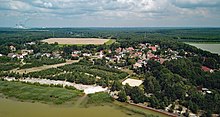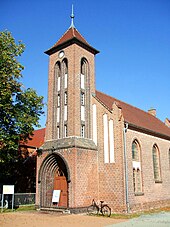Burghammer
|
Burghammer
Bórkhamor community Spreetal
Coordinates: 51 ° 28 ′ 30 ″ N , 14 ° 22 ′ 20 ″ E
|
|
|---|---|
| Height : | 111 m above sea level NN |
| Area : | 6.31 km² |
| Residents : | 237 (Dec. 31, 2009) |
| Population density : | 38 inhabitants / km² |
| Incorporation : | January 1, 1996 |
| Postal code : | 02979 |
| Area code : | 035727 |
Burghammer , in Upper Sorbian Bórkhamor , is a district of the Spreetal municipality in the Bautzen district in Saxony . Like the surrounding villages, Burghammer is part of the Sorbian settlement area in Upper Lusatia .
geography

Burghammer lies on the old road from Spremberg to Hoyerswerda between Burgneudorf and Burg . To the south of the village is the Amber Lake, which was created by flooding the Burghammer opencast mine . The Kleine Spree flows through the village coming from Burg in the direction of Burgneudorf.
history
Local history
Burghammer was first mentioned in 1596 as a Hammerwerk zum Burgk in a document from the Hoyerswerda lordship . The hammer mill was able to fall back on three favorable location factors: There were larger deposits of lawn iron stone in the vicinity, there was enough wood for charcoal coking in the surrounding forests to generate the necessary heat, and the water power of the Kleine Spree was sufficient to drive the hammer.
At the end of the 18th century a school and a prayer house were inaugurated. In 1864 a Sunday school for hammer mill workers was opened.
In 1897 the volunteer fire brigade Burghammer and in 1903 a fire brigade music corps was founded. During this time, a fire watch tower was built, which was also used as a lookout tower.
From 1936 a church tower was built, which was consecrated in 1939 and equipped with a second bell. The neighboring town of Neudorf , which was larger at the time , was incorporated into Burghammer in 1938. During the war years, a prison camp was stationed in Burghammer, which mainly housed French, Russian and English people.
After the war, the community and the rest of the Hoyerswerda district came back to the state of Saxony, but through the administrative reform of 1952 , the smaller district of Hoyerswerda was connected to the more Brandenburg district of Cottbus .
Burghammer underwent a significant change in 1955 with the opening of the Burghammer opencast mine , in which lignite was mined until 1973. Also in 1973 a new school complex was opened in the relatively central town of Burgneudorf.
After the fall of the Wall , the eponymous neighboring town of Burg was incorporated on January 1, 1994 , reducing the number of communities in today's Spreetals district to three: Burghammer, Neustadt and Spreewitz . These communities formed the administrative community Burgneudorf (later Administrative Association Burgneudorf), from which the community Spreetal emerged on January 1, 1996.
By the flooding of the former mining wheel , Burghammer and Spreetal and the associated stop the drainage, there was a groundwater rebound. This took place faster in the entire municipality and was higher than expected. In 2007 the allotment garden, which was founded in 1982, had to be abandoned, and in 2008 the first houses in the lower parts of the village of Burghammer were raised.
Population development
| year | Residents |
|---|---|
| 1825 | 154 |
| 1871 | 272 |
| 1885 | 318 |
| 1905 | 432 |
| 1925 | 385 |
| 1939 | 1026 |
| 1946 | 941 |
| 1950 | 966 |
| 1964 | 1658 |
| 1990 | 945 |
| 1995 | 1256 |
| 2009 | 237 |
| italics: community with districts | |
Towards the end of the 18th century, 14 cottage families lived in Burghammer who made their living primarily by working in the hammer mill.
In the 19th century, the population increased rapidly, so that it almost tripled within 80 years from 154 in 1825 to 432 in 1905. This was followed by a population decline, so that in 1925 there were still 385 inhabitants, while in the same period the population of Burgneudorf more than doubled from 306 to 703. As a result of the incorporation of Burgneudorf, the population of the municipality of Burghammer rose to over 1000 for the first time, although in 1939 the number of inhabitants was slightly lower than in 1925.
After the Second World War, the community had a little less than 1,000 inhabitants, but the number rose again due to the need for workers in the opencast mine, so that in the mid-sixties there were almost 1,700 inhabitants. The number of residents fell more sharply than the GDR average, so that in 1990 it was only 950. With the incorporation of Burg, the population of the community rose again to over 1000.
Despite a slight decrease in the number of inhabitants, 1,121 residents with main residence in the four former Burghammer districts (Burg, Burghammer, Burgneudorf and Spreetal) were registered as of December 31, 2008.
The population was originally purely Sorbian, it was not until the 19th and early 20th centuries that Germanization began. In the first half of the 1880s, the Sorbian scientist Arnošt Muka counted only 6 Germans among the 173 inhabitants in the actual village, which corresponds to a Sorbian population of 96.5%. At that time, the majority of the German workers were already in the colony, so that Muka only counted 67 Sorbs (41.6%) of the 161 inhabitants. By 1956, according to Ernst Tschernik , the proportion fell further to just 13.3%.
Place name
The place name reflects what the place was originally - a hammer mill near Burg, whereby the place name of Burg itself is a borrowing from Sorbian. The Hammerwerk zum Burgk was mentioned in documents in 1596 , the Burker Hammersleuthe in 1658 and the Burcker Hammer in 1732 . From this, Burckhammer bey Burgk developed in 1791 and finally Burghammer in 1800 .
The Sorbian place name Bórkhamor corresponds to the German, where bórk- denotes a pine forest. With Hamor the Sorbian term for an iron hammer, in the name he appears among others in the Sorbian names of Boxberg , Hamor , and Nové Rietschen , Nowy Hamor on.
literature
- 400 years of Burghammer . Burghammer 1996.
Individual evidence
- ^ Burghammer in the Digital Historical Directory of Saxony
- ↑ Saxony regional register. Retrieved April 28, 2009 .
- ↑ Residents' registration office Spreetal: Statistical - Burghammer. Retrieved May 22, 2013 .
- ^ Ludwig Elle: Language policy in the Lausitz . Domowina-Verlag, Bautzen 1995, p. 249 .
Web links
- Burghammers website
- Burghammer on the website of the municipality of Spreetal




